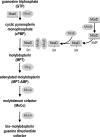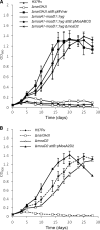Functional analysis of molybdopterin biosynthesis in mycobacteria identifies a fused molybdopterin synthase in Mycobacterium tuberculosis
- PMID: 20971904
- PMCID: PMC3019926
- DOI: 10.1128/JB.00774-10
Functional analysis of molybdopterin biosynthesis in mycobacteria identifies a fused molybdopterin synthase in Mycobacterium tuberculosis
Abstract
Most mycobacterial species possess a full complement of genes for the biosynthesis of molybdenum cofactor (MoCo). However, a distinguishing feature of members of the Mycobacterium tuberculosis complex is their possession of multiple homologs associated with the first two steps of the MoCo biosynthetic pathway. A mutant of M. tuberculosis lacking the moaA1-moaD1 gene cluster and a derivative in which moaD2 was also deleted were significantly impaired for growth in media containing nitrate as a sole nitrogen source, indicating a reduced availability of MoCo to support the assimilatory function of the MoCo-dependent nitrate reductase, NarGHI. However, the double mutant displayed residual respiratory nitrate reductase activity, suggesting that it retains the capacity to produce MoCo. The M. tuberculosis moaD and moaE homologs were further analyzed by expressing these genes in mutant strains of M. smegmatis that lacked one or both of the sole molybdopterin (MPT) synthase-encoding genes, moaD2 and moaE2, and were unable to grow on nitrate, presumably as a result of the loss of MoCo-dependent nitrate assimilatory activity. Expression of M. tuberculosis moaD2 in the M. smegmatis moaD2 mutant and of M. tuberculosis moaE1 or moaE2 in the M. smegmatis moaE2 mutant restored nitrate assimilation, confirming the functionality of these genes in MPT synthesis. Expression of M. tuberculosis moaX also restored MoCo biosynthesis in M. smegmatis mutants lacking moaD2, moaE2, or both, thus identifying MoaX as a fused MPT synthase. By implicating multiple synthase-encoding homologs in MoCo biosynthesis, these results suggest that important cellular functions may be served by their expansion in M. tuberculosis.
Figures





Similar articles
-
Cleavage of the moaX-encoded fused molybdopterin synthase from Mycobacterium tuberculosis is necessary for activity.BMC Microbiol. 2015 Feb 6;15(1):22. doi: 10.1186/s12866-015-0355-2. BMC Microbiol. 2015. PMID: 25651977 Free PMC article.
-
Structural analysis of molybdopterin synthases from two mycobacterial pathogens.Biochem Biophys Res Commun. 2019 Mar 26;511(1):21-27. doi: 10.1016/j.bbrc.2019.02.024. Epub 2019 Feb 11. Biochem Biophys Res Commun. 2019. PMID: 30765225
-
Structural comparison of three MoaE proteins in Mycobacterium tuberculosis: Insights into molybdopterin synthase assembly and specificity.Biochem Biophys Res Commun. 2025 Jul 1;768:151945. doi: 10.1016/j.bbrc.2025.151945. Epub 2025 May 5. Biochem Biophys Res Commun. 2025. PMID: 40345009
-
Molybdenum enzymes, their maturation and molybdenum cofactor biosynthesis in Escherichia coli.Biochim Biophys Acta. 2013 Aug-Sep;1827(8-9):1086-101. doi: 10.1016/j.bbabio.2012.11.007. Epub 2012 Nov 29. Biochim Biophys Acta. 2013. PMID: 23201473 Review.
-
Shared function and moonlighting proteins in molybdenum cofactor biosynthesis.Biol Chem. 2017 Aug 28;398(9):1009-1026. doi: 10.1515/hsz-2017-0110. Biol Chem. 2017. PMID: 28284029 Review.
Cited by
-
High throughput phenotypic selection of Mycobacterium tuberculosis mutants with impaired resistance to reactive oxygen species identifies genes important for intracellular growth.PLoS One. 2013;8(1):e53486. doi: 10.1371/journal.pone.0053486. Epub 2013 Jan 8. PLoS One. 2013. PMID: 23320090 Free PMC article.
-
Genome-wide mutational biases fuel transcriptional diversity in the Mycobacterium tuberculosis complex.Nat Commun. 2019 Sep 5;10(1):3994. doi: 10.1038/s41467-019-11948-6. Nat Commun. 2019. PMID: 31488832 Free PMC article.
-
Comparing the Metabolic Capabilities of Bacteria in the Mycobacterium tuberculosis Complex.Microorganisms. 2019 Jun 18;7(6):177. doi: 10.3390/microorganisms7060177. Microorganisms. 2019. PMID: 31216777 Free PMC article. Review.
-
ATP-binding cassette (ABC) import systems of Mycobacterium tuberculosis: target for drug and vaccine development.Emerg Microbes Infect. 2020 Jan 27;9(1):207-220. doi: 10.1080/22221751.2020.1714488. eCollection 2020. Emerg Microbes Infect. 2020. PMID: 31985348 Free PMC article. Review.
-
Prokaryotic ubiquitin-like protein modification.Annu Rev Microbiol. 2014;68:155-75. doi: 10.1146/annurev-micro-091313-103447. Epub 2014 May 29. Annu Rev Microbiol. 2014. PMID: 24995873 Free PMC article. Review.
References
-
- Akhter, Y., S. Yellaboina, A. Farhana, A. Ranjan, N. Ahmed, and S. E. Hasnain. 2008. Genome scale portrait of cAMP-receptor protein (CRP) regulons in mycobacteria points to their role in pathogenesis. Gene 407:148-158. - PubMed
-
- Aly, S., K. Wagner, C. Keller, S. Malm, A. Malzan, S. Brandau, F. C. Bange, and S. Ehlers. 2006. Oxygen status of lung granulomas in Mycobacterium tuberculosis-infected mice. J. Pathol. 210:298-305. - PubMed
-
- Brodin, P., Y. Poquet, F. Levillain, I. Peguillet, G. Larrouy-Maumus, M. Gilleron, F. Ewann, T. Christophe, D. Fenistein, J. Jang, M. S. Jang, S. J. Park, J. Rauzier, J. P. Carralot, R. Shrimpton, A. Genovesio, J. A. Gonzalo-Asensio, G. Puzo, C. Martin, R. Brosch, G. R. Stewart, B. Gicquel, and O. Neyrolles. 2010. High content phenotypic cell-based visual screen identifies Mycobacterium tuberculosis acyltrehalose-containing glycolipids involved in phagosome remodeling. PLoS Pathog. 6:e1001100. - PMC - PubMed
Publication types
MeSH terms
Substances
LinkOut - more resources
Full Text Sources
Other Literature Sources
Molecular Biology Databases

